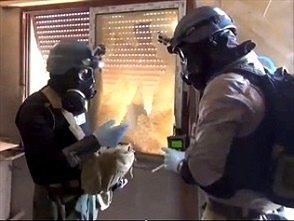New York Times on Syria: All the propaganda fit to print

In a front-page article Tuesday, the New York Times reported that a United Nations report released the day before on the August 21 chemical weapons attack in the suburbs of Damascus “strongly implicated the Syrian government.”
In fact, the report did no such thing. The story’s headline, “UN implicates Syria in using chemical weapons,” is a cynical distortion of reality tailored to meet the needs of the US government for war propaganda.
While the UN inspectors reported “clear and convincing evidence” that surface-to-surface rockets carrying sarin gas were used in the attack, the report provided no indication as to whether it was government forces that fired these rockets, or the Al Qaeda-led “rebels” that are backed by Washington and its allies. As the report states, “The conclusion is that chemical weapons have been used in the ongoing conflict between the parties in the Syrian Arab Republic.”
These inspectors were invited into Syria by the government of President Bashar al-Assad and were set to investigate three separate sites of reported chemical weapons attack, which the Assad regime has blamed on the Islamist anti-government militias. In one of these, which took place on March 19 on the village of Khan al Assal outside Aleppo, the majority of the victims were government soldiers.
Neither the Times nor anyone else charging the Assad regime with ordering the August 21 attack have presented any explanation for why it would do so on the very day that the weapons inspectors that it had invited into Syria were beginning their work just a 15-minute walk away from the site of the attack. On the other hand, the motive for the “rebels” to stage such an attack and blame it on the government is obvious: to provoke Western military intervention in support of their flagging insurgency.
The Times article does not concern itself with such questions. Rather, it deduces from the report’s findings that only the government could have been responsible. This is based fundamentally on the assertion that the “rebel forces … are not known to possess such weapons.” It similarly quotes US ambassador to the United Nations Samantha Powers as claiming that there is “no evidence that the opposition possesses sarin.”


























